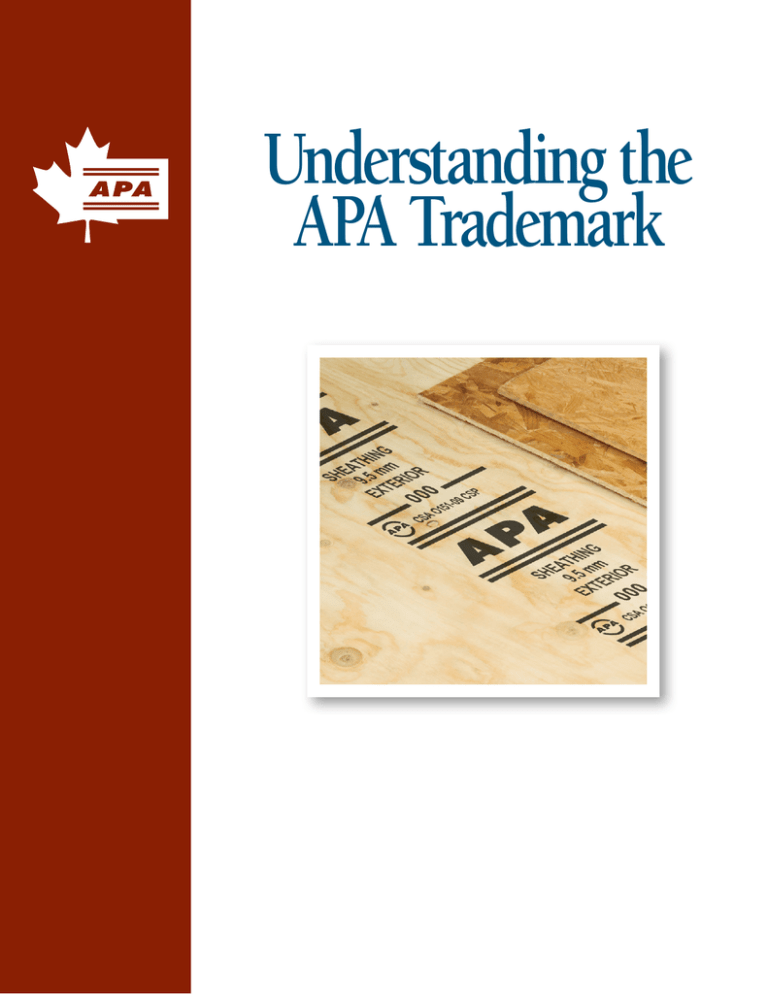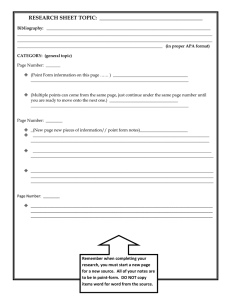
Understanding the
APA Trademark
APA – The Engineered Wood Association
APA – The Engineered Wood Association represents North American manufacturers of plywood, OSB,
glulam, I-joists, and structural composite lumber. Since its inception in 1933, APA has led the industry
as an innovator in technical research and as the provider of the most rigorous product testing and quality
auditing program in the field.
Currently representing 84 percent of structural wood panel producers in North America, APA is known
for a well-demonstrated commitment to rigorous quality assurance, technical research and testing,
national and international standards development, and a highly regarded safety and health program that
fosters industry-wide excellence in safety.
APA is committed to the needs of its Canadian members, maintaining a close working relationship with
the Canadian Standards Association (CSA) in the development and maintenance of Canada's national
consensus standards for wood-based panels and other engineered wood products. APA staff actively
participates in CSA A369, Technical Committee on Wood-Based Panels, CSA A370, Technical Committee
on Solid and Engineered Wood Products, and CSA O86, Engineering Design in Wood, as well as ASTM,
ANSI, CIB, and ISO.
Form No. Q800 ■ © 2015 APA – The Engineered Wood Association ■ www.apawood.org 2
The APA Mark of Quality
Much more than just a logo, the APA trademark is a guide to panel performance
The APA trademark is a manual in a mark. It tells the panel use, maximum support spacing (for OSB),
thickness, exposure, manufacturer, and code or standard.
The APA mark signifies that product quality is subject to verification through APA audit—a rigorous program of
testing and quality control that demonstrates the manufacturer's commitment to ongoing, independent product
testing. The mark assures manufacture in conformance with the standard shown in the mark.
PLYWOOD TRADEMARK
Panel Grade
Nominal Panel Thickness
(Optional for standard panel thicknesses)
SHEATHING
12.5 mm
EXTERIOR
000
CSA O121-08 DFP
Bond Classification
Mill Number
Product Standard
OSB TRADEMARK
Panel Grade
Span Rating (U.S. Format)
Bond Classification
Labeled Panel Thickness
(Optional)
APA's Performance
Rated Panel Standard
Mill Number
Product Standard and Grade
HUD Recognition
Performance Category
Panel Grade
Panel Mark — Rating and
End-Use Designation in
Accordance with CSA O325
Canadian OSB Standard
Panel Face
Orientation Indicator
Form No. Q800 ■ © 2015 APA – The Engineered Wood Association ■ www.apawood.org 3
Plywood
Versatile, stable, and strong:
the original engineered wood product
Plywood has been one of the most recognized and trusted wood building
products for decades. Manufactured from thin sheets of cross-laminated
veneer and bonded under heat and pressure with moisture-resistant adhesives,
plywood panels have superior dimensional stability and an excellent strengthto-weight ratio and are highly resistant to static and impact loads, chemicals,
and changes in environmental temperature and humidity.
Plywood manufactured by APA member mills is available in a wide variety of
appearance grades, ranging from smooth, natural surfaces suitable for finish
work to more economical grades used for sheathing. With more than a dozen
common thicknesses and over twenty different grades, APA-trademarked
plywood is well-suited to a multitude of demanding applications, including
subflooring, single-layer flooring, wall and roof sheathing, marine applications,
and concrete forming. Plywood is a solid choice for industrial applications like
pallets, industrial containers, mezzanine decks, and furniture, too.
PLYWOOD PANELS FOR ALL PURPOSES
Sheathing & Rough Surfaces
Workhorse panels for construction and industry
Sanded, Solid, & Repaired Faces
Uniform appearance, uniform thickness
Enhanced Faces, Overlaid & Coated
Rugged panels for punishing conditions
Concrete Forming
Reuse time after time
Special Features
Unique lay-ups, custom surfaces, oversized
Form No. Q800 ■ © 2015 APA – The Engineered Wood Association ■ www.apawood.org 4
Plywood Specifications
Sizes and Thicknesses
SHEATHING
12.5 mm
EXTERIOR
APA EXTERIOR Plywood (DFP, CSP, and Aspen) is manufactured in a size of
1220 mm by 2440 mm, the metric equivalent of the familiar 4 ft by 8 ft panel. It is also
available in a metric size of 1200 mm by 2400 mm. Net face widths for tongue-and-groove
panels are given in Table 1. APA Plywood is manufactured in thicknesses ranging from 6 mm
to 31.5 mm (See Table 1).
000
CSA O121-08 DFP
TABLE 1
SIZES AND THICKNESSES OF APA EXTERIOR PLYWOOD(a,b)
Sanded
Thicknesses
Sheathing &
Select Thicknesses
Sizes
6 mm
19 mm
7.5 mm
20.5 mm
(c)
(c)
8 mm
21 mm
9.5 mm
22.5 mm
11 mm
24 mm(c)
12.5 mm(c)
25.5 mm(c)
14 mm
27 mm(c)
15.5 mm(c)
28.5 mm(c)
17 mm(c)
30 mm(c)
18.5 mm(c)
31.5 mm(c)
(c)
(c)
Lengths
Available up to 2500 mm
Widths
Available from 600 mm to 1250 mm
For tongue-and-groove panels, deduct 15mm
from the nominal width for net face coverage.
NOTES:
(a)All thicknesses are metric, but some approximate imperial dimensions, e.g., 6 mm (1/4 in.)
(b)APA EXTERIOR plywood panels are available in additional sizes and thicknesses on special order.
(c) Available as square edge or with tongue-and-groove edge.
Species
Plywood marked APA EXTERIOR under CSA O121, CSA O151, CSA O153 may be designated Douglas-fir (DFP), Canadian
Softwood (CSP), Poplar or Aspen plywood. Canadian Softwood (CSP) includes several species of spruce and pine. APA
Exterior Douglas-fir plywood is manufactured with faces of Douglas-fir veneers. The inner plies and some backs may be of
veneers of selected coniferous species. For a list of species, refer to the APA Canadian Plywood Grading Guide, Form Q701.
Plywood Grades and Products
APA member manufacturers produce a wide range of EXTERIOR plywood grades and products. They also produce
Medium Density (MDO) and High Density (HDO) overlaid plywood, tongue-and-groove plywood, concrete form panels,
and specialty panels.
Form No. Q800 ■ © 2015 APA – The Engineered Wood Association ■ www.apawood.org 5
Oriented Strand Board (OSB)
Sheathing panels with
consistent properties
and performance
Manufactured from moistureresistant heat-cured adhesives and
wood strands that are arranged
in cross-oriented layers, OSB
shares many of the strength and
performance characteristics of
plywood. OSB's combination of
wood and adhesives creates a strong,
dimensionally stable panel that
resists deflection, delamination,
and warping; likewise, panels resist
racking and shape distortion when
subjected to demanding wind and
OSB Specifications
Sizes and Thicknesses
OSB is manufactured in large sheets. Commonly available
panel sizes include 1220 mm by 2440 mm, the metric
equivalent of the familiar 4 ft by 8 ft panel, as well as a
metric size of 1200 mm by 2400 mm. Larger width and
lengths are also available. Commonly available OSB
thicknesses in mm (in.): 7.9 (5/16 in.), 8.7 mm (11/32 in.),
9.5 mm (3/8 in.), 11.0 mm (7/16 in.), 12.0 mm (15/32 in.),
12.7 mm (1/2 in.), 15.0 mm (19/32 in.), 15.9 mm (5/8 in.),
18.0 mm (23/32 in.), 19.1 mm (3/4 in.)
Performance Standards
Dual mark for
APA Performance Rated Panels are designed to meet or
U.S. and Canada
exceed standards of performance for their intended end use.
Two common grades of Performance Rated Panels are APA
Rated Sheathing and APA Rated Sturd-I-Floor. In Canada, Performance Rated Panels
are identified by CSA O325, Construction Sheathing, in the trademark.
seismic conditions.
APA-trademarked OSB is suitable
Panel Marks and Span Ratings
for a variety of end uses including
A “Panel Mark” or “Span Rating” is a one- or two-number series that gives the
maximum recommended center-to-center spacing (in inches) of supports when the long
panel dimension or strength axis is perpendicular to supports (unless otherwise noted).
subflooring, single-layer flooring,
wall and roof sheathing, ceiling/
deck sheathing, structural insulated
panels, and more.
On APA Rated Sheathing, the panel mark appears in the trademark as two number
series separated by a slash. The number on the left contains the letter “R” which
represents “roof” followed by the maximum recommended spacing of supports
when the panel is used for roof sheathing with the strength axis across three or more
supports. The series to the right of the slash contains the letter “F” for “floor” followed
by the maximum recommended spacing of supports when the panel is used for
subflooring with the strength axis across three of more supports. A “W” represents
recommended spacing of supports for wall applications and appears most often on
Rated Siding panels.
Preceding the letter “F” or “R” in the end
use mark on floor and roof panels is either
the number 1 or 2. A number 1 indicates
that the panel so marked may be used at
its maximum rated span without requiring
edge support or a layer of underlay. An end
use mark starting with a 2 means that the
panel will require edge support or a layer of
underlay at its rated span.
Form No. Q800 ■ © 2015 APA – The Engineered Wood Association ■ www.apawood.org 6
©2013 APA – THE ENGINEERED WOOD ASSOCIATION • ALL RIGHTS RESERVED. • ANY COPYING, MODIFICATION, DISTRIBUTION OR OTHER USE OF THIS PUBLICATION OTHER THAN AS EXPRESSLY AUTHORIZED BY APA IS PROHIBITED BY THE U.S. COPYRIGHT LAWS.
APA: The Leading Resource
for Information about
Engineered Wood Products
From detailed product information to training material to
personal technical assistance, APA offers an authoritative
and comprehensive set of services, tools, and resources.
APA Product Support Help Desk
Our engineered wood specialists are available
to answer questions about the specification and
application of APA products. Ask a question online
at www.apawood.org/help, or call (253) 620-7400 to
speak to one of our specialists.
APA Publications
WWW.APAWOOD.ORG
APA’s primary website features a
wealth of knowledge. Find member
manufacturers. Learn about engineered
wood products and APA’s current
technical research. Get in-depth design
and building support. View educational
webinars. Browse or download the many
publications available in our resource
library, featuring over 500 publications.
Visit www.apawood.org.
APACAD.ORG
APA’s comprehensive selection of publications is
curated to meet the needs of a large audience, including
architects, engineers, specifiers, dealer/distributors, code
More than 200 free CAD details for
wood-frame construction. Download
details in DWG, DWF, DXF and PDF
format. Visit www.apacad.org.
officials, students, and industry insiders. New titles are
added regularly to satisfy the needs and interests of our
PERFORMANCEPANELS.COM
large audience. Many of APA’s technical publications
Technical data, product information
and other resources specific to industrial
applications of engineered wood panels.
Visit www.performancepanels.com.
serve as the definitive authority on their subject and are
regularly revised to reflect the latest technical research.
APA’s titles include basic construction tips for builders,
product design and construction guides, wood market
WOOD UNIVERSITY
analysis and forecasts, case studies, technical topics and
Online educational portal features
free courses about engineered wood
products and applications.
Visit www.wooduniversity.org.
research reports, and much, much more. APA’s collection
of publications is available at www.apawood.org/
resource-library.
Form No. Q800 ■ © 2015 APA – The Engineered Wood Association ■ www.apawood.org 7
Understanding the APA Trademark
We have field representatives in many major U.S. cities and in Canada
who can help answer questions involving APA trademarked products.
For additional assistance in specifying engineered wood products, contact us:
A PA H E A D Q UA R TE R S
7011 So. 19th St. ■ Tacoma, Washington 98466
(253) 565-6600 ■ Fax: (253) 565-7265
P RO D U C T SU P P O R T H E LP D E S K
(253) 620-7400 ■ help@apawood.org
D I SC L A I M E R
The information contained herein is based on APA – The Engineered Wood Association’s c­ ontinuing
programs of laboratory testing, product research, and comprehensive field experience. Neither
APA, nor its members make any warranty, expressed or implied, or assume any legal liability or
responsibility for the use, application of, and/or reference to opinions, findings, conclusions, or recommendations included in this publication. Consult your local jurisdiction or design professional to
assure compliance with code, construction, and performance requirements. Because APA has no
control over quality of workmanship or the conditions under which engineered wood products are
used, it cannot accept responsibility for product performance or designs as actually constructed.
Form No. Q800/Issued March 2015


